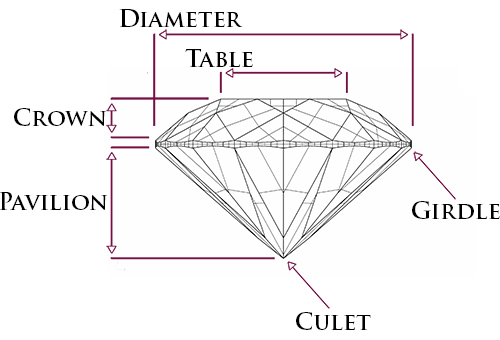
 Color
Color
Diamonds occur naturally in many colors, from the purest white to the deepest fancy color. One of the factors used to determine a diamond's quality is the color of the diamond. For white diamonds, the most popular, the color grade actually refers to the lack of color. These diamonds are graded on an alphabetical scale, starting at D, which is the whitest color, and going down the alphabet to Z, which has a distinctly yellow hue. Color grades D, E, and F are considered colorless, but the human eye can't usually distinguish a yellow tint until color grade J. For color grades below J, the color is easily distinguished when placed next to a colorless diamond. The color grading scale used by the Gemological Institute of America (GIA) is shown below:

It's important not to confuse a noticeably yellow grade with yellow fancy diamonds. Fancy yellow diamonds have a much deeper and richer yellow color and like all colored diamonds, are considerably more rare than white diamonds. All fancy colors (yellow, pink, blue, and others) have their own grading scale.
 Clarity
Clarity
Diamonds are pure carbon, compressed under tremendous pressure and heat until a clear crystal is formed. These crystals are then mined, cut, and polished to be the beautiful gems we use for jewelry. Because of how they are formed, most diamonds contain natural imperfections, which are called inclusions. Like fingerprints, each diamond's inclusions are unique. Although most inclusions are microscopic, the location, size, and number all affect the clarity grade of the diamond. Because they often cannot be seen by the naked eye, most inclusions do not affect the diamond's beauty.

FL and IF (Flawless and Internally Flawless):
These are the rarest clarity grades for a diamond. There are no imperfections in these diamonds, of any kind, under 10x magnification.
VVS1 and VVS2 (Very Very Slightly Included grades 1 and 2):
These diamonds have one or more very, very small imperfections that can only be seen under 10x magnification. Because these inclusions are incredibly small and difficult to find, even an expert diamond grader may have to devote considerable time to locating them during the grading process.
VS1 and VS2 (Very Slightly Included grades 1 and 2):
Like VVS diamonds, Very Slighted Included diamonds contain very small imperfections that can only be seen under 10x magnification. However, the inclusions in VS diamonds are easier to see than in VVS diamonds, but they are still difficult to find under 10x magnification.
SI1 and SI2 (Slightly Included grades 1 and 2):
Although Slightly Included diamonds contain inclusions that are easily found by an expert under 10x magnification, they cannot be seen by the naked eye.
I1 (Included grade 1):
Included diamonds contain one or more imperfections. Although they are visible to the naked eye, some may not be easily found because of size and location.
I2 (Included grade 2):
I2 diamonds, like I1 diamonds, contain at least one imperfection which is visible to the naked eye, but I2 diamonds usually have multiple imperfections also visible to the naked eye.
I3 (included grade 3)
I3 diamond, will have even more imperfections visible to the naked eye, or can have one rather large imperfection easily visible to the untrained eye.
 Cut
Cut
The cut and shape of diamonds are often confused. The shape of a diamond is the physical shape, like Round (circle), Princess (square), Emerald, Cushion, just to name a few. Diamonds can be cut in just about any shape, but the shape of the diamond is not one of the Four C’s.

In contrast, the cut of a stone refers to how well the diamond reflects light. Facets are cut into the diamond and when light hits the stone, it is refracted within the diamond and that is what gives diamonds their brilliance (sparkle). A typical round stone has 58 facets, which is the standard for round diamonds. As shown in the chart below, if the stone's facets are cut well, the light enters the top of the stone and is reflected out again. But if the diamond is too deep or too shallow, the light enters the top and is reflected out the bottom, making the stone lose brilliance.

Understanding some of the terms
Table: The largest facet of the diamond as its name indicates is at the top of the diamond.
Crown: The portion of the diamond between the table and the girdle.
Girdle: The portion between the crown and the pavilion that circumvent the diamond.
Diameter: The measure in a straight line of the diamond across its widest part side to side.
Pavilion: The part of the diamond forming the lower part of the diamond extending down from the girdle to the culet.
Culet: The bottom of the diamond where all the facets meet to form a point. A very small facet not visible to the naked eye ( usually graded as none to small)

 Carat
Carat
Carat refers to how much the diamond weighs. In the jewelry industry, a point refers to .01 carats. This means that a half-carat diamond (0.50ct) is 50 points and a one-carat diamond (1.00ct) equals 100 points. A one-carat, well cut round diamond should be approximately 6.50mm in diameter, which is about a quarter of an inch. Below you can see how different sizes compare to each other (please note that these diamonds are not shown actual size).

